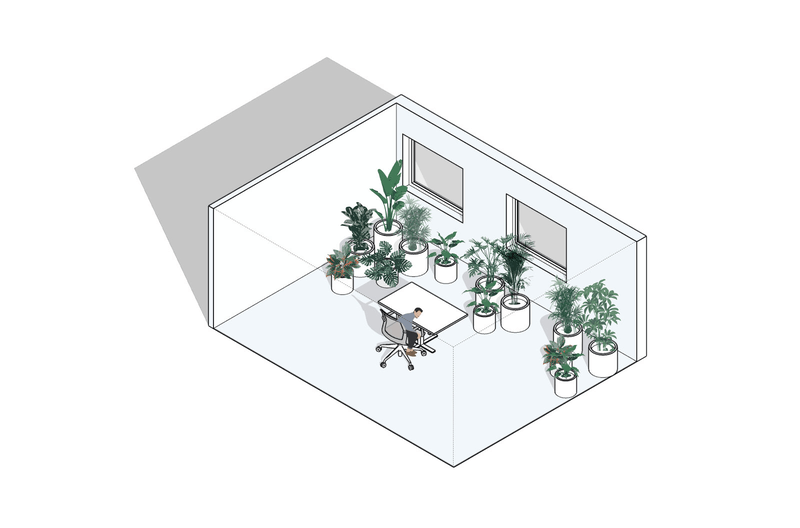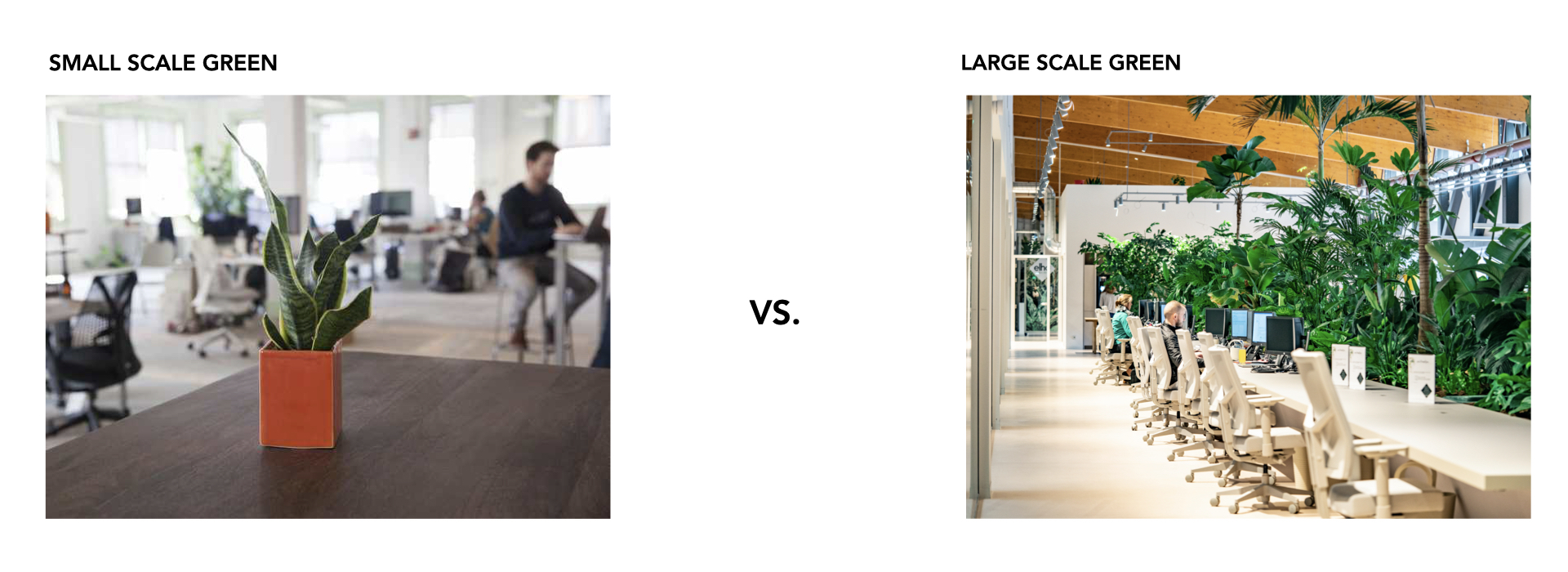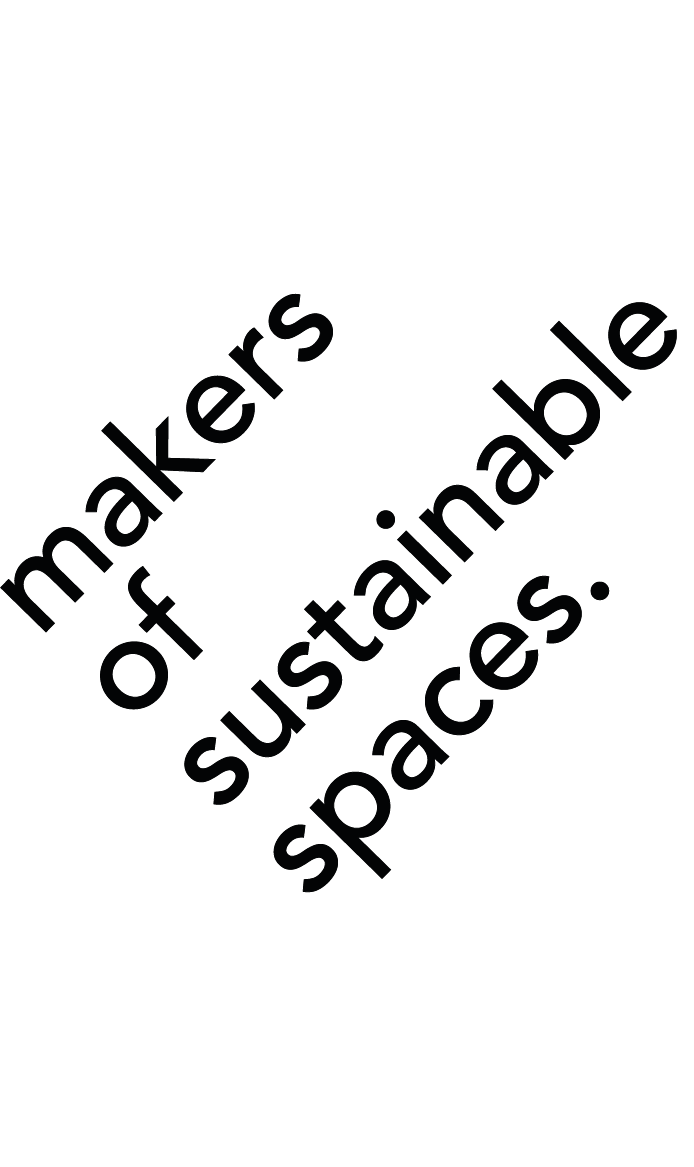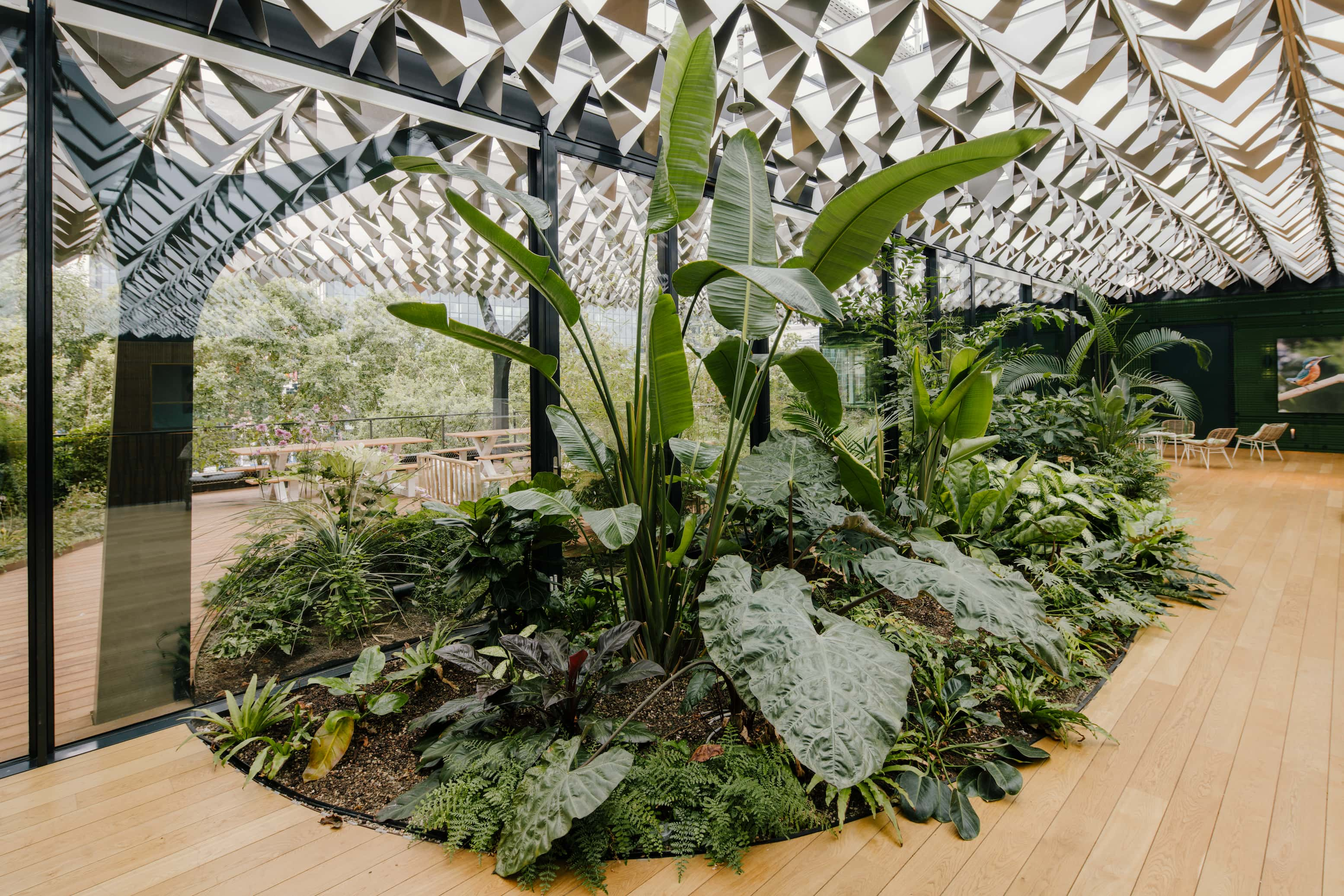

31 Mar MOSS Lab 1.0: Green Impact Metrics
Written by Tessel Pool | Research conducted by Marlies Elbertse and facilitated by MOSS.
It is commonly understood that exposure to nature is beneficial for people, and we are gaining an increasing amount of knowledge about the positive impacts of bringing greenery to indoor spaces.
Prolonged exposure to plants ameliorates Volatile Organic Compounds (VOCs), relative humidity, carbon dioxide, and benefits occupant wellbeing amongst other things (1). Until now there has been a lack of research on the impact of green when implemented at different scales:
HOW MANY PLANTS ARE NEEDED TO MAKE A POSITIVE IMPACT?
In a research experiment driven by Kelai Diebel from Makers of Sustainable Spaces (MOSS) and conducted by Marlies Elbertse from the University of Wageningen is the first of its kind and a breakthrough for our progressive understanding of the importance of plants. The experiment bridges the gap between the benefits of plants indoors and the wellbeing of employees in buildings.
What is revealed in Elbertse’s scientific undertakings brings forth entirely new information that, when scaled up and implemented throughout the built environment, can positively impact people around the world and significantly contribute to more sustainable and healthier future cities.
We are generation-indoor: a society spending on average 90% of our lives in indoor environments. Considering that the average person also spends 60% of their waking hours working, Kelai and Marlies sought to better understand working conditions with respect to the green layer.
We understand that when the environment in which we spend the majority of our time, such as a home or in this case an office, does not meet the needs of the users, negative effects occur. The research findings provide a solution to mitigate the negative impacts of our highly urban and technologically-driven environments.

HOW MUCH IS ENOUGH?
At the time of the study, the academic literature on designing green spaces was inadequate. It was difficult to compare findings as every study used different quantities, species, distances, and durations. No general understanding of what is exactly required to realize optimal well-being in space was available.
The International WELL Building Institute creates building standards to enhance human health and well-being (2). In the WELL standard, v1, a feature states that at least 1% of the floor area must be covered by plants, plus one living wall should be included per floor (3). Note that this standard does not specify the size or height of plants, nor the overall volume of green.
In WELL v2, one feature requires that “any combination of indoor plants are within a direct line of sight of at least 75% of workstations” (4), but also does not prescribe the amount, size, or volume of indoor greenery to be implemented.
When measuring the impact plants can have on people, MOSS believes that it is important to work with cubic metrics of the foliage. When only using surface area, as adhered to in the WELL Building Standard v1, it is easy to choose short plants and thus the result is inconsistent.
Consider this for example: one short plant can have the same footprint as a tall plant, but they have a very different scale when measuring volume and therefore a completely different effect on impact!
The research team at MOSS and Wageningen University took this opportunity to study the impact of different scales of greenery to understand both perceived and physical variables of stress, productivity, and workplace satisfaction.


The team approached the experiment with three conditions: first a control condition with no indoor green (0%), the second condition with a plant pot (0.5%) as a representation of the current state of greenery in many offices, and the third condition with the most plants (8%) often used by MOSS as a benchmark in projects. This means the study room was filled with different amounts of plants, based on the m3 volume of foliage as illustrated above.
[An example of how MOSS used 8% greenery to design the offices for Goede Doelen Loterijen]
The research method entailed various steps that were carried out three times for 30 minute periods each. The participant’s heart rate was monitored at different times throughout the experiment with the help of a Fitbit to evaluate stress levels. Productivity was measured by partaking in sudoku puzzles and afterwards, a questionnaire was handed out to measure both stress levels, perceived productivity and workplace satisfaction.
Fun fact: the participants thought they were being studied for Fitbits but in fact had no idea it was all about green!
The central research question was:
What is the effect of different volumes of indoor greenery on employees’ well-being?
Sub-questions included:
-
- What is the effect of different volumes of indoor greenery on employees’ (perceived) stress?
- What is the effect of different volumes of indoor greenery on employees’ (perceived) productivity?
- What is the effect of different volumes of indoor greenery on employees’ perceived workplace satisfaction?
FINDINGS AND RELEVANCE
The research findings demonstrate that the spaces with increased volumes of greenery contribute to happier, healthier and more relaxing workplaces as this is where the participants perceived less stress and experienced more productivity.
These findings are relevant for the primary users of indoor spaces who will benefit most from the positive effects of greenery, as well as all built environment practitioners who have an impact on how spaces are designed and realized. More specifically, the outcomes of this study are relevant for some of the reasons stipulated below.
-
- We all know that when we feel well, we perform well.
- We are continuously learning how to improve our indoor environments by implementing more nature.
- Designing spaces based on green volume with impact in mind, means that we can positively impact people’s health and wellbeing. Every bit counts!
- Our time indoors has increased as a result of the Covid-19 pandemic, and learning to improve our spaces to accommodate this change through green is vital.


This pioneering research conceptualized and managed by MOSS and executed in collaboration with the University of Wageningen, is the first in the world to have extracted data on the impact of different scales of greenery in indoor spaces.
The findings concluded that the most favorable amount of green was directly related to the 8% scenario, which is also preferred by MOSS and executed in many of their projects.
The outcome of the 8% scenario, which is the highest volume of plants, has the most positive effect on the variables analyzed in this research.
The participant’s heart rate, and therefore stress levels were reduced significantly in addition to an increase in productivity levels. This also suggests that when implementing 8% of green into a space, users will be more satisfied in the space.
Interestingly, some of the participants’ preferred the 0.5% as they believed more plants would distract them from said task. However, all of the quantitative data proves otherwise and the higher the volume of greenery, the better for the user and the environment.
This year we will work with a second WUR ACT student group to reveal data on how plants may ameliorate the acoustic quality of work environments, and how we can design to optimize sound absorption. Stay tuned for more!
SOURCES
- McCormick, Kathleen. The Business Case for Healthy Buildings, The Urban Land Institute, 2018, globalwellnessinstitute.org/wp-content/uploads/2018/12/Business-Case-for-Healthy-Buildings-FINAL.pdf.
- WELL. (2020a, September 15). WELL v2 is here. Retrieved 6 September 2021, from https://resources.wellcertified.com/articles/well-v2-is-here/
- WELL. (2020b, January 1). Biophilia I – Qualitative. Retrieved 23 September 2021, from https://standard.wellcertified.com/mind/biophilia-i-qualitative
- WELL. (2021, January 1). Nature and Place. Retrieved 23 September 2021, from https://v2.wellcertified.com/wellv2/en/mind/feature/2



